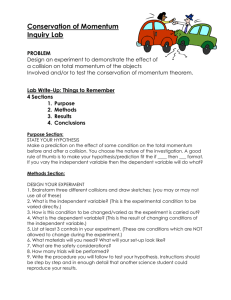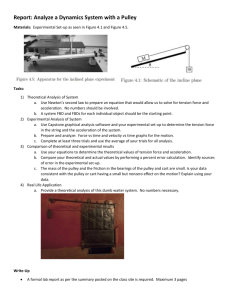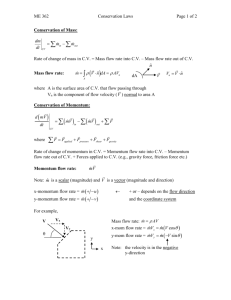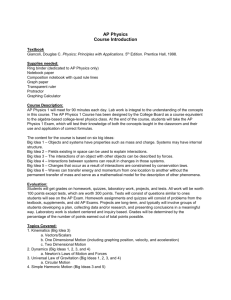File
advertisement
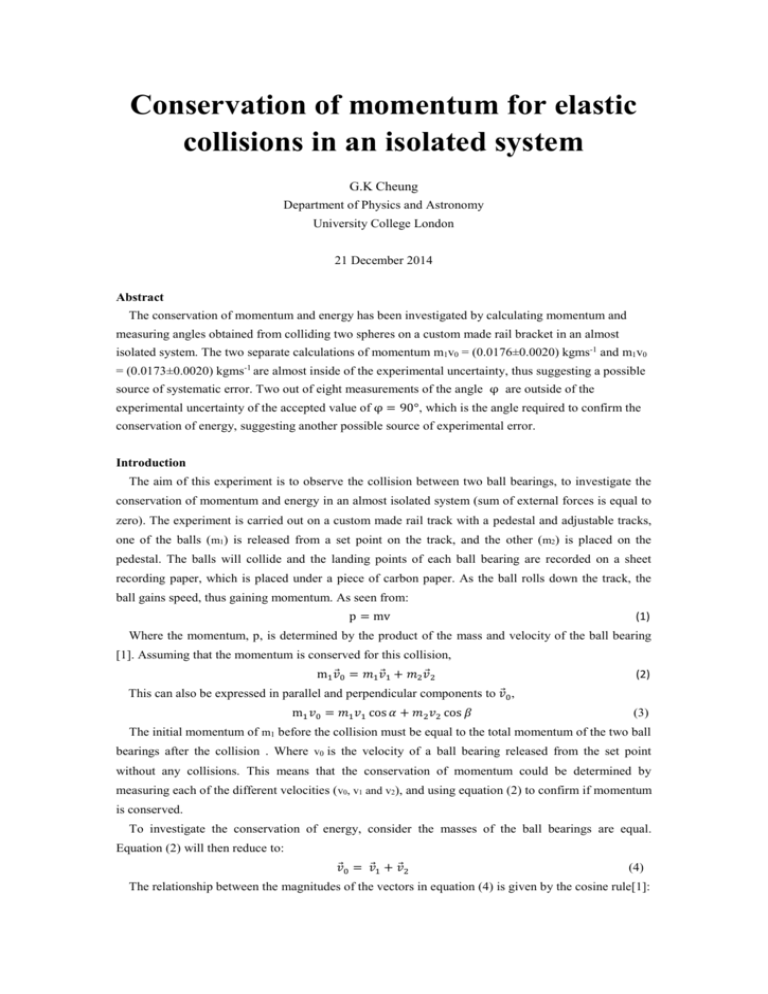
Conservation of momentum for elastic collisions in an isolated system G.K Cheung Department of Physics and Astronomy University College London 21 December 2014 Abstract The conservation of momentum and energy has been investigated by calculating momentum and measuring angles obtained from colliding two spheres on a custom made rail bracket in an almost isolated system. The two separate calculations of momentum m1v0 = (0.0176±0.0020) kgms-1 and m1v0 = (0.0173±0.0020) kgms-1 are almost inside of the experimental uncertainty, thus suggesting a possible source of systematic error. Two out of eight measurements of the angle φ are outside of the experimental uncertainty of the accepted value of φ = 90°, which is the angle required to confirm the conservation of energy, suggesting another possible source of experimental error. Introduction The aim of this experiment is to observe the collision between two ball bearings, to investigate the conservation of momentum and energy in an almost isolated system (sum of external forces is equal to zero). The experiment is carried out on a custom made rail track with a pedestal and adjustable tracks, one of the balls (m1) is released from a set point on the track, and the other (m2) is placed on the pedestal. The balls will collide and the landing points of each ball bearing are recorded on a sheet recording paper, which is placed under a piece of carbon paper. As the ball rolls down the track, the ball gains speed, thus gaining momentum. As seen from: p = mv (1) Where the momentum, p, is determined by the product of the mass and velocity of the ball bearing [1]. Assuming that the momentum is conserved for this collision, m1 𝑣⃗0 = 𝑚1 𝑣⃗1 + 𝑚2 𝑣⃗2 (2) This can also be expressed in parallel and perpendicular components to 𝑣⃗0, m1 𝑣0 = 𝑚1 𝑣1 cos 𝛼 + 𝑚2 𝑣2 cos 𝛽 (3) The initial momentum of m1 before the collision must be equal to the total momentum of the two ball bearings after the collision . Where v0 is the velocity of a ball bearing released from the set point without any collisions. This means that the conservation of momentum could be determined by measuring each of the different velocities (v0, v1 and v2), and using equation (2) to confirm if momentum is conserved. To investigate the conservation of energy, consider the masses of the ball bearings are equal. Equation (2) will then reduce to: 𝑣⃗0 = 𝑣⃗1 + 𝑣⃗2 (4) The relationship between the magnitudes of the vectors in equation (4) is given by the cosine rule[1]: v02 = 𝑣12 + 𝑣22 − 2𝑣1 𝑣2 cos 𝜑 Landing v2 Point 0 (5) point 1 v0 α β φ Landing point 2 v1 Figure 1: The relationship between velocities of equal masses after an elastic collision Now consider the collision to be perfectly elastic, the kinetic energy will be conserved [3], 1 2 𝑚𝑣02 = 1 2 1 𝑚𝑣12 + 𝑚𝑣22 (6) 2 Therefore, it will reduce to, v02 = v12 + v22 (7) Equation (7) turns out to be the same as equation 5 when φ = 90°. This suggests that energy will be conserved when φ = 90°, hence allowing the investigation of the conservation of energy simply by measuring φ, and see if it equals to 90°.[4] Method The schematic diagram of the system in the experiment is shown in figure 2, it is a custom made rail bracket, with a track that could be adjusted using blue tack. Point 0 is determined by inserting an optical pin in the hole of the pedestal, to determine the initial point of collision. The height of the pedestal is then adjusted to ensure meter on the track. d0 =20.9±0.05cm v0 m1 m2 h1=8.1±0.05cm Landing points h2= 19.1±0.05cm Pedestal Point 0 Recording sheet & Carbon Paper Figure 2: The schematic diagram of the conservation of momentum system m1 and m2 are measured using an electronic scale, which are both m1 and m2 = (16.3±0.05)g. Releasing the masses in this experiment are all done with a ruler instead of using hands to ensure reliability. m1 is initially released from h1 = (8.1±0.05)cm above the horizontal plane of collision, without anything on the pedestal. M1 will fall with a horizontal velocity on to the recording sheet. This 1 gives the distance between point 0 and v0, d0 = (20.9±0.05)cm. Using h2 = 𝑔𝑡 2 , where g is the 2 gravitational acceleration on Earth, the time of flight could be found, thus v0 could be obtained using v= 𝑑 (8) 𝑡 The experiment could then be done with both m1 and m2, where the previous steps apply but with m2 on the pedestal. Releasing m1 and colliding with m2 gives two landing points on the recording sheet, assign the pair of results with a number. The distances between the landing points and point 0 are then measured, giving values of d1 and d2. Repeat the experiment for 5 landings as opposed to the 10-20 landings from the established procedures for each angle; adjust the angle 5 times, to ensure clear results. Multiple values of v1 and v2 could then be obtained using equation (8) where t is the same as the one in the calculation of v0. The conservation of momentum could be determined by comparing the values of m1v0 from equation (2) and the value of m1v0 obtained from multiplying v0 from equation (8) with m1. Conservation of energy could be determined through the measurement of φ as seen in fig.1, and see if the measurement matches with φ = 90°. Results & Analysis The velocities of the two spheres after collision is shown in table 1. It is calculated using equation (8) ∆𝐴 ∆𝐵 𝐴 𝐵 and the uncertainty is propagated using ∆z = z√( )2 + ( )2 . -1 d1/m v1/ms d2/m v2/ms-1 0.132±0.001 0.670±0.090 0.065±0.001 0.330±0.040 0.118±0.001 0.599±0.080 0.109±0.001 0.553±0.070 0.085±0.001 0.431±0.060 0.134±0.001 0.680±0.090 0.064±0.001 0.325±0.040 0.142±0.001 0.721±0.100 Table 1: Speed and distances from point 0 to the landing points The velocities could then be used to calculate the momentum for each of the spheres after the collision, using equation (1), hence allowing the calculating of the total momentum before the collision using equation (2). The uncertainty of the momentum is propagated using ∆z = √(∆𝐴)2 + (∆𝐵)2 . The momentums of the spheres are shown in table 2. m1/kg m2/kg m1v1/kgms-1 m2v2/kgms-1 m1v0/kgms-1 0.0163±0.0001 0.0163±0.0001 0.0109±0.0010 0.0054±0.0010 0.0163±0.0020 0.0163±0.0001 0.0163±0.0001 0.0098±0.0010 0.0090±0.0010 0.0188±0.0020 0.0163±0.0001 0.0163±0.0001 0.0070±0.0010 0.0111±0.0010 0.0181±0.0020 0.0163±0.0001 0.0163±0.0001 0.0053±0.0010 0.0118±0.0020 0.0171±0.0020 Table 2: Mass and momentum for each sphere after the collision and momentum before collision The weighted mean of m1v0 gives m1v0 = (0.0176±0.0020) kgms-1, which when compared with the results obtained from multiplying v0 with m1, m1v0 = (0.0173±0.0020) kgms-1, they roughly agree with one another within one standard deviation. The slight difference between the values suggests a systematic error in the experiment. The suspected source of such error could be the spheres hitting the pedestal during their fall. This causes some of the energy to be transferred into the pedestal and also an upwards projection is caused by the reaction force on the pedestal. By comparing and seeing if the angles of φ = 90°, the conservation of energy could be concluded. The angle φ for each pair of points is measured using a protractor, and the anomalies are excluded. The measured angles for each pair of results obtained would be displayed in table 3. Angles/° 90±0.5 131±0.5 93±0.5 131±0.5 130±0.5 90±0.5 140±0.5 89±0.5 Table 3: The angles 𝛗 measured from the experimental results Only two out of eight results measured equals to 90°, this overall does not agree with the expected value ofφ = 90°. This suggests a systematic error in which the suspected source of error could once again be the spheres hitting the pedestal. The large angles only occur when it is far away from point 0, but all the points nearer to the point 0 are at 90°or somewhat close to 90°. This suggests that because some energy is transferred into the pedestal and an upwards projection is caused upon hitting the pedestal, the spheres further away from point 0 could not travel as far as it theoretically could. This explains the large angle which otherwise be close to 90° if it had travelled its full length. Conclusion In conclusion, the data suggests that the momentum is conserved, as m1v0 calculated using v0 roughly agrees with the m1v0 calculated with equation (2) within one standard deviation. Although it does not fully agree, but it is suspected to be a systematic error caused by the spheres hitting the pedestal during their fall. The data also suggests that energy is not conserved and the collision was not elastic because only two out of eight results agrees with the expected value ofφ = 90°. Anomalous results also occur when the track angle is not very wide, which suggests that having a small angle allows the sphere to hit the pedestal hence anomalous results are produced. Both of these suggest that a systematic error is not accounted for. From the results we could predict that any alterations in the experiment such as changing the release height would not cause any major differences in the final results, and that the momentum could still be seen as conserved. And that energy might be conserved if the pedestal problem was fixed through proper adjustments to make sure the spheres do not hit it when falling. If the energy is deemed not conserved even after fixing the pedestal problem, it can be said that the energy is not conserved in an almost isolated system due to the loss of energy to the surroundings. The experiment could be improved by increasing the number of repeats and using more precise measuring instruments to increase reliability. The experiment could also be improved to have the pedestal already fixed in place in a position where the spheres could not hit it during the fall. References [1] R.P. Feynman, R.B. Leighton, S. Mathew, The Feynman lectures on physics, Volume 1, Addison-Wesley, 1964 [2] G.A. Wentworth, Plane and Spherical Trigonometry, BiblioBazaar, 2009. [3] R.A. Serway & J.W Jewett, Physics for Scientists and Engineers, Brooks/Cole, 2004 [4] P.A. Barlett & J.R.Grozier, NX1 Conservation of Momentum, 2014
